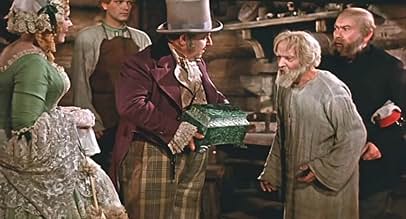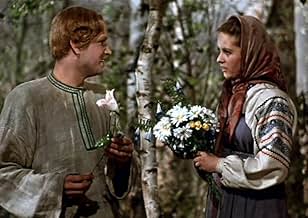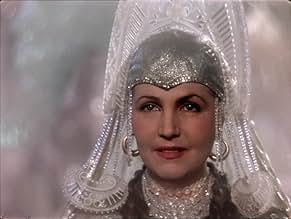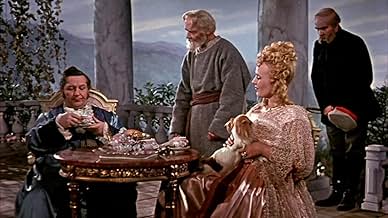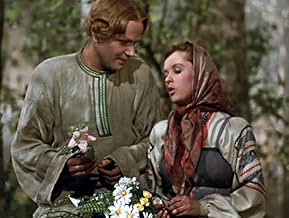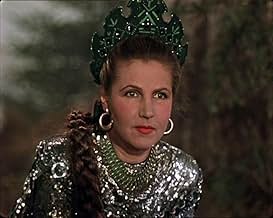VALUTAZIONE IMDb
7,1/10
558
LA TUA VALUTAZIONE
Aggiungi una trama nella tua linguaObsessed with perfecting his craft, young gemcutter Danilo visits the mystical Copper Mountain to uncover the secret behind its infamous attraction - the Stone Flower, a stone carving so cap... Leggi tuttoObsessed with perfecting his craft, young gemcutter Danilo visits the mystical Copper Mountain to uncover the secret behind its infamous attraction - the Stone Flower, a stone carving so captivating that no one can leave after seeing it.Obsessed with perfecting his craft, young gemcutter Danilo visits the mystical Copper Mountain to uncover the secret behind its infamous attraction - the Stone Flower, a stone carving so captivating that no one can leave after seeing it.
- Regia
- Sceneggiatura
- Star
- Premi
- 2 vittorie e 2 candidature totali
Vladimir Druzhnikov
- Danilo - master
- (as V. Druzhnikov)
Yekaterina Derevshchikova
- Katya
- (as Y. Derevshchikova)
Mikhail Troyanovskiy
- Prokopych
- (as M. Troyanovsky)
Mikhail Yanshin
- Severyan
- (as M. Yanshin)
Nikolay Temyakov
- Barin
- (as N. Temyakov)
Anna Petukhova
- Barina
- (as A. Petukhova)
Nikolai Orlov
- Stary master
- (as N. Orlov)
Lidiya Deikun
- Vikhorika
- (as L. Deikun)
Serafim Zaytsev
- Yefimka
- (as S. Zaytsev)
Vitaliy Kravchenko
- Danilo - malchyk
- (as V. Kravchenko)
Recensioni in evidenza
I saw The Stone Flower back in the forties shortly after it was released. I have never forgotten it. The color was so amazing that some of the images have remained permanently imprinted in my brain! I am disappointed that it is unavailable on video nor have I ever seen t revived anywhere where I have been. I am glad there are at least a few others who remember it.
An old man recounts a fairy-tale to a group of children about a stone-cutter, "Danila", who strives for perfection and meets with the mystical "Queen of Copper Hill". She asks him to sacrifice himself and remain with her in her unreachable world of stone at the expense of his married life with "Katinka", the girl he loves and whom he has just married.
The film is made in colour which is refreshing for 1946 and it is 15 minutes longer than described on IMDb. However, the story drags. The Russian hierarchy is very effectively captured - we witness the cruelties of the ruling classes who take to flogging the poor. They don't just flog them, they beat them to death for not working hard enough or not finishing a piece of work in time. Danila's talent at stone sculpture results in him being commissioned to make a piece for a wealthy landowner who wants to show off. However, the "Queen of Copper Hill" intervenes. It takes ages for this part of the story to get going, though.
Vladimir Druzhnikov is good in the lead role as "Danila". He looks a bit gay and girlie and very much suits the artistic type that is required for the film. The sets within the world of stone in Copper Hill are interesting in a "Star Trek" kind of way but each section of the film just seems to drag on for too long. Apart from the dance sequence in the wedding episode - one of the more entertaining parts of the film.
I also felt that the ending of the film could have been better. It's a happy-ending story but it would have been far more effective as a tragedy. We are led to believe that the Queen of Copper Hill has an evil sacrifice up her sleeve and that someone is going to get turned to stone for eternity. This is exactly what the film needs. But it doesn't happen. She suddenly switches to a goodie and we get a "love conquers all" message which is a disappointment. The film keeps you watching with false expectations and I felt cheated at the end. The rules suddenly change from "You can never go back!" to "Ok you can go back now". Very lame. The film needed an effective finale, ie, some tragedy, to redeem the rest of the tedious film but it didn't happen. It scores for novelty value only.
The film is made in colour which is refreshing for 1946 and it is 15 minutes longer than described on IMDb. However, the story drags. The Russian hierarchy is very effectively captured - we witness the cruelties of the ruling classes who take to flogging the poor. They don't just flog them, they beat them to death for not working hard enough or not finishing a piece of work in time. Danila's talent at stone sculpture results in him being commissioned to make a piece for a wealthy landowner who wants to show off. However, the "Queen of Copper Hill" intervenes. It takes ages for this part of the story to get going, though.
Vladimir Druzhnikov is good in the lead role as "Danila". He looks a bit gay and girlie and very much suits the artistic type that is required for the film. The sets within the world of stone in Copper Hill are interesting in a "Star Trek" kind of way but each section of the film just seems to drag on for too long. Apart from the dance sequence in the wedding episode - one of the more entertaining parts of the film.
I also felt that the ending of the film could have been better. It's a happy-ending story but it would have been far more effective as a tragedy. We are led to believe that the Queen of Copper Hill has an evil sacrifice up her sleeve and that someone is going to get turned to stone for eternity. This is exactly what the film needs. But it doesn't happen. She suddenly switches to a goodie and we get a "love conquers all" message which is a disappointment. The film keeps you watching with false expectations and I felt cheated at the end. The rules suddenly change from "You can never go back!" to "Ok you can go back now". Very lame. The film needed an effective finale, ie, some tragedy, to redeem the rest of the tedious film but it didn't happen. It scores for novelty value only.
Seen shortly after it was released. A beautiful, and apparently rare film, since I have never seen a video of it available. Easily equal to the work of Serge Eisenstein, produced during the Stalinist days of the USSR, but is a telling of a famous Russian fable. An excellent film, which should be on video.
This faux (?) folktale, probably the best known film of Soviet fabulist Aleksandr Ptushko, is a paean to artistic individuality: a daydreaming youth becomes protégé to an old stone carver; visits the secret cave of a mountain witch to delve into his art; and then, with the unwavering trust of his deserted bride, finds his way back into the world as absolute master of his craft. A rather non-collective idea to find in the Stalinist film world of the time. Ptushko's style often looks like some over-decorated/Russian-themed Christmas window, but it certainly fits his subject. The crudity in the technique comes off as sincerity and the USSR color processing of the era is often quite lovely if you boost the brightness level on your equipment. Aimed at kids, but probably best for grown up cultural Sovietologists.
NOTE: Check out the DVD extras for an amazing stop-motion animation clip from Ptsuhko's 1936 pic THE NEW GULLIVER.
NOTE: Check out the DVD extras for an amazing stop-motion animation clip from Ptsuhko's 1936 pic THE NEW GULLIVER.
10holcombe
I saw "The Stone Flower" in 1952 at Iowa State University's (then a state college) student union. I was a second or third grader, but I have never forgotten the magic of this Russian fable, the movie's gorgeous images and its powerful drama. I remember a wicked queen who turned the heroine into stone and the soft images of the lush rose-colored stone flower that remained for the hero to find after great struggles with the evil queen and her sinister minions.
Some sets were simple and rather bare. I like the earlier comment about "The Red Shoes," another post-war film from the recovering European film industries, with the same pre-war quality story lines and great effort to use color and images well, but with truly scarce resources.
I am so thrilled to find that others remember this wonderful film that seemed to have disappeared. I hope someone can find a print to share with film historians and certainly with other children. More than 50 years later, I can thank my mother for taking me to share the beautiful Stone Flower that I have never forgotten.
Some sets were simple and rather bare. I like the earlier comment about "The Red Shoes," another post-war film from the recovering European film industries, with the same pre-war quality story lines and great effort to use color and images well, but with truly scarce resources.
I am so thrilled to find that others remember this wonderful film that seemed to have disappeared. I hope someone can find a print to share with film historians and certainly with other children. More than 50 years later, I can thank my mother for taking me to share the beautiful Stone Flower that I have never forgotten.
Lo sapevi?
- ConnessioniFeatured in Good Bye, Sowjetunion! (2021)
I più visti
Accedi per valutare e creare un elenco di titoli salvati per ottenere consigli personalizzati
Dettagli
- Tempo di esecuzione1 ora 29 minuti
- Mix di suoni
- Proporzioni
- 1.37 : 1
Contribuisci a questa pagina
Suggerisci una modifica o aggiungi i contenuti mancanti

Divario superiore
By what name was Il fiore di pietra (1946) officially released in Canada in English?
Rispondi
